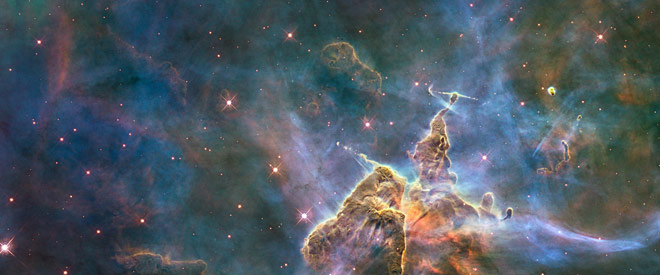- Part I: Introduction
- Part II: Milestones to All Destinations
- Part III: Utilization of Space Technology and Resources
- Part IV: To the Moon
- Part V: To Mars
- Part VI: To the Asteroids
- Part VII: To Orbital Space Settlements
- Part VIII: To the Stars (this page)
- Outline of the Roadmap
- PDF version of entire Roadmap (6 MB)
- Order full color print version
Part VIII: To the Stars

MILESTONE 20: Development of Interstellar Travel.
Eventually, methods developed to enable humans to travel to other stars.
The stars are far away, the nearest being more than four light years away, and totally unreachable by any propulsion system currently in existence. However, it remains a dream for humanity to expand into the universe and live among the stars. We know that planets are commonplace and Earth-like planets are expected to be found somewhere among the nearer stars. While Earth-like (or similar) planets may be a primary destination, it is also known that planets are not needed for human habitation of another solar system because asteroids are likely to be available to support populations in orbital settlements in numbers larger than what planetary surfaces could support.
Scientific and technological breakthroughs may hasten the time when interstellar travel is possible. For example, breakthroughs in the biological sciences may enable us to modify humans to be better star travelers. Also, NASA has supported modest programs seeking scientific breakthroughs in propulsion physics. Any such breakthrough could accelerate settlement of our own solar system in addition to helping to reach the stars. A “breakthrough” by definition is unpredictable. However, it seems very unlikely that any such breakthrough would be sufficiently dramatic that it would allow travel back and forth between stars in a meaningful time-frame. It is more likely that the best technology would only allow colony ships to make one-way trips to plant the first human homes in another solar system.
Such colony ships could take several forms. They could be “generation ships” in which the descendants of the original crew will be the ones who reach the final destination — or in which a “generation” is much longer than ours if life spans are greatly extended in the future. Or they could use some form of suspended animation which would allow the crew to travel for decades or centuries and be revived at their destination. Or they could be a fully self-sufficient orbital settlement with a relatively large population; a space city that orbits the Sun could also orbit another star.
Once a solar system around another star is reached, human inhabitants could spread out and build a civilization there, and then repeat the process around other, more distant stars.
Further Reading:
CODA:
Once established throughout the solar system, humans will be truly out of their cradle, and the risk of extinction will be much reduced. When established around multiple stars, the future of humanity will be virtually unbounded. Ad Astra!







